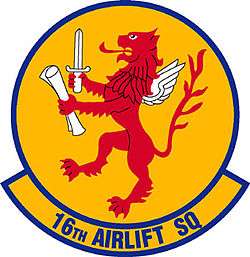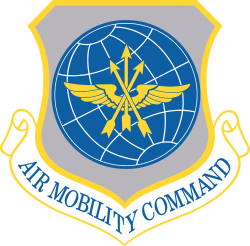16th Airlift Squadron
| 16th Airlift Squadron | |
|---|---|
 A 16th Airlift Squadron loadmaster exits a C-17 Globemaster III aircraft at Joint Base Charleston | |
| Active | 1940–1945; 1947–1948; 1950–1955; 1969–2000; 2002–present |
| Country |
|
| Branch |
|
| Type | Airlift |
| Part of | Air Mobility Command |
| Garrison/HQ | Joint Base Charleston |
| Engagements |
Mediterranean Theater of Operations China Burma India Theater[1] |
| Decorations |
Distinguished Unit Citation Air Force Outstanding Unit Award[1] |
| Insignia | |
| 16th Airlift Squadron emblem (approved 17 December 1980)[1] |
 |
| 16th Troop Carrier Squadron emblem (approved 25 June 1951)[2] |
 |
The 16th Airlift Squadron is one unit of three active duty Boeing C-17 Globemaster III squadrons at Joint Base Charleston, South Carolina.
Overview
The 16th Airlift Squadron is commanded by a Lieutenant Colonel, who serves as the leader of the squadron, including the pilots. The Chief Loadmaster is in charge of the loadmasters and the First Sergeant takes charge of the few support military personnel and civilians working in the squadron.
History
World War II
Activated in December 1940 flying converted Douglas DC-2 transport aircraft as a GHQ Air Force transport squadron. Converted to Douglas C-47 Skytrains in early 1942, trained under I Troop Carrier Command for combat operations. Assigned to VIII Air Support Command, Eighth Air Force and deployed to England in August 1942, providing transport to the newly established American Air Force.
Was transferred to Algiers, Algeria in November 1942, and attached, being later assigned to Twelfth Air Force as part of the North African Campaign. The squadron's aircraft flew supplies to front-line units in Algeria and Tunisia as soon as suitable landing strips were available and evacuated casualties back to rear area field hospitals. A flight of the squadron deployed to Tenth Air Force in India during the fall of 1942, to assist in the re-supply of Brigadier General Merrill and his men, affectionately known as "Merrill's Marauders". It was during this Ceylon, Burma, India campaign that the squadron received its first Distinguished Unit Citation, returning to Tunisia by the end of the year.
The squadron moved to Sicily, dropping airborne forces onto the island during Operation Husky, then moved to forward airfields in Italy during 1943 as part of the Italian Campaign. Just prior to D Day, part of the 16th left India for Italy to tow gliders into France on "D" Day. In July 1944, the detached unit was joined by the remainder of the 16th at Ciampino Airport, Italy and as the European Theater closed in on Germany, part of the 16th again went on detached service to Rosignano Airfield, Italy, operating resupply missions to Greek partisans during September to October 1944.
In the fall of 1944, moved to France in support of Operation Anvil, the Allied invasion of Southern France, and supported ground forces moving north through the Rhone Valley to link up with Allied forces moving east from Normandy. Returned to Northern Italy in early 1945, supporting the drive into the Po River Valley and the end of combat in Italy during May 1945. The squadron also hauled food, clothing, medicine, gasoline, ordnance equipment, and other supplies to the front lines and evacuated patients to rear zone hospitals.
In late May 1945, after V-E Day, the squadron moved to Waller Field, Trinidad and attached to Air Transport Command. From Trinidad, the squadron ferried returning military personnel to Morrison Field, Florida, where they were sent on to other bases or prepared for separation after the war. Inactivated at the end of July 1945.
Tactical airlift in the Cold War
Reactivated briefly in 1947–1948 at Langley Field, Virginia as a Tactical Air Command troop carrier squadron, but never fully manned or equipped.
Reactivated during the Korean War at Sewart Air Force Base, Tennessee and equipped with Fairchild C-119 Flying Boxcars and other assault transports to be used for airborne combat assault operations. Performed training for combat units, but remained in the United States. Moved to Ardmore Air Force Base, Oklahoma in 1954 and was inactivated in 1955.
Reactivated during the Vietnam War as a Lockheed C-130 Hercules airlift training squadron at Sewart Air Force Base, moved to Little Rock Air Force Base in 1970 with the closure of Sewart.
Strategic airlift
Remained in the training role until 1993 until being moved to Charleston Air Force Base and becoming an operational Lockheed C-141 Starlifter heavy airlift squadron. Inactivated with the retirement of the Starlifter in 2000, reactivated with Boeing C-17 Globemaster IIIs in 2002.
Lineage
- Constituted as the 16th Transport Squadron on 20 November 1940
- Activated on 11 December 1940
- Redesignated 16th Troop Carrier Squadron on 4 July 1942
- Inactivated on 31 July 1945
- Activated on 19 May 1947
- Inactivated on 10 September 1948
- Redesignated 16th Troop Carrier Squadron, Assault, Light on 19 September 1950
- Activated on 5 October 1950
- Redesignated 16th Troop Carrier Squadron, Assault, Fixed Wing on 8 November 1954
- Inactivated on 8 July 1955
- Redesignated 16th Tactical Airlift Training Squadron on 14 August 1969
- Activated on 15 October 1969
- Redesignated 16th Airlift Squadron on 1 December 1991
- Inactivated on 29 September 2000
- Activated on 1 July 2002[1]
Assignments
- 64th Transport Group (later 64th Troop Carrier Group), 11 Dec 1940 – 31 Jul 1945
- 64th Troop Carrier Group, 19 May 1947 – 10 Sep 1948
- 316th Troop Carrier Group, 5 October 1950
- Eighteenth Air Force (attached to 463d Troop Carrier Wing), 14 Nov 1954 – 8 Jul 1955
- 4442d Combat Crew Training Wing, 15 October 1969
- 314th Tactical Airlift Wing, 1 August 1971
- 34th Tactical Airlift Training Group, 1 November 1978
- 314th Operations Group, 1 December 1991
- 437th Operations Group, 1 October 1993 – 29 September 2000
- 437th Operations Group, 1 July 2002 – present[1]
Stations
|
|
Aircraft
|
|
Awards and campaigns
- Campaigns. World War II: Algeria-French Morocco; Tunisia; Sicily; Naples-Foggia; Rome-Arno; Southern France; North Apennines; Po Valley; India-Burma; Air Combat, EAME Theater.
- Decorations. Distinguished Unit Citation: CBI Theater, 7 Apr-15 Jun 1944. Air Force Outstanding Unit Awards: 30 Sep 1975 – 30 Jun 1976; 1 Jun 1985 – 31 May 1986; 1 Jul 1991 – 30 Jun 1993; 1 Jul 1993 – 30 Jun 1995; 1 Jul 1995 – 30 Jun 1997; 1 Jul 1997 – 30 Jun 1998; 1 Jul 1998 – 29 Sep 2000.
References
Notes
Bibliography
![]()
- Johnson, 1st Lt. David C. (1988). U.S. Army Air Forces Continental Airfields (ETO) D-Day to V-E Day (PDF). Maxwell AFB, AL: Research Division, USAF Historical Research Center. Archived from the original (PDF) on September 29, 2015. Retrieved June 26, 2017.
- Maurer, Maurer, ed. (1983) [1961]. Air Force Combat Units of World War II (PDF) (reprint ed.). Washington, DC: Office of Air Force History. ISBN 0-912799-02-1. LCCN 61060979. Retrieved December 17, 2016.
- Maurer, Maurer, ed. (1982) [1969]. Combat Squadrons of the Air Force, World War II (PDF) (reprint ed.). Washington, DC: Office of Air Force History. ISBN 0-405-12194-6. LCCN 70605402. OCLC 72556. Retrieved December 17, 2016.
- Ravenstein, Charles A. (1984). Air Force Combat Wings, Lineage & Honors Histories 1947-1977 (PDF). Washington, DC: Office of Air Force History. ISBN 0-912799-12-9. Retrieved December 17, 2016.

